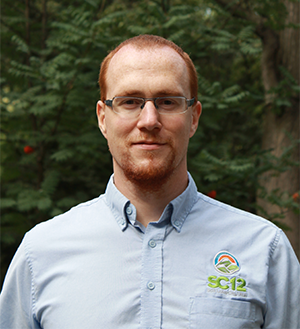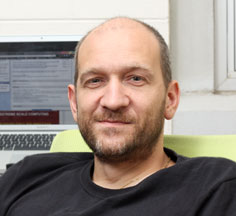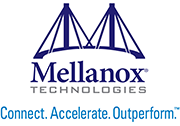
Half Day Tutorials
- TUTORIAL 1 - Torsten Hoefler …Updated 9/25
- TUTORIAL 2 - Marc-Andre Hermanns…Updated 9/24
- TUTORIAL 3 - George Bosilca, Aurelien Bouteiller…Updated 9/15
TUTORIAL 1
»A tarball of the examples used during the tutorial…Updated 9/25
| Title : | Advanced MPI: New Features of MPI-3 | |
| Presenter : | Torsten Hoefler, ETH, Switzerland |  |
| − Abstract − | ||
The new series of MPI standards (MPI-3.0 and MPI-2.2) react to several developments in HPC systems and applications that happened during the last decade. The modernized standard adds several key-concepts to deal with programming massively parallel modern hardware systems. In this tutorial, we will cover the three major concepts: (1) nonblocking collectives and flexible communicator creation, (2) greatly improved remote memory access (RMA) programming, and (3) topology mapping to improve locality and neighborhood ("build your own") collective operations. Nonblocking collectives enable to write applications that are resilient to small time variations (noise), overlap communication and computation, and enable new complex communication protocols. The new remote memory access semantics allow to efficiently exploit modern computing systems that offer RDMA but require a new way of thinking and developing applications. Topology mapping allows to specify the application's communication requirements and enables the MPI implementation to optimize the process-to-node mapping. Last but not least, neighborhood collectives form a powerful mechanism where programmers can specify their own collective operation and allow the MPI implementation to apply additional optimizations. Content Level Audience Prerequisites Targeted Audience
|
||
TUTORIAL 2
| Title : | Practical Hybrid Parallel Application Performance Engineering | |
| Presenters : | Marc-Andre Hermanns, RWTH Aachen University, JARA-HPC |
 |
| Allen Malony, University of Oregon | ||
| Matthias Weber, TU Dresden, Germany | ||
| − Abstract − | ||
This tutorial presents state-of-the-art performance tools for leading-edge HPC systems founded on the Score-P community-developed instrumentation and measurement infrastructure, demonstrating how they can be used for performance engineering of effective scientific applications based on standard MPI, OpenMP, hybrid combination of both, and increasingly common usage of accelerators. Parallel performance tools from the Virtual Institute - High Productivity Supercomputing (VI-HPS) are introduced and featured in demonstrations with Scalasca, Vampir, Periscope and TAU. We present the complete workflow of performance engineering, including instrumentation, measurement (profiling and tracing, timing and PAPI hardware counters), data storage, analysis, and visualization. Emphasis is placed on how tools are used in combination for identifying performance problems and investigating optimization alternatives. The knowledge gained in this tutorial will help participants to locate and diagnose performance bottlenecks in their own parallel programs. Content Level Audience Prerequisites Targeted Audience
|
||
TUTORIAL 3
»A tarball of the examples used during the ULFM tutorial…Updated 9/15
| Title : | Resilient applications using MPI-level constructs | |
| Presenters : | George Bosilca, Innovative Computing Laboratory - University of Tennessee |
 |
| Aurelien Bouteiller, Innovative Computing Laboratory - University of Tennessee |
 |
|
| − Abstract − | ||
As supercomputers are entering an era of massive parallelism, the frequency of failures, or the costs incurred to prevent such failures to impact applications, is expected to grow significantly. Unlike more traditional fault management methods, user-level fault-tolerance techniques have the potential to prevent full-scale application restart and therefore lower the cost incurred for each failure, but they demand from the communication middleware the capability to detect and notify failures and resume communications afterward. In the context of MPI, the Fault Tolerance Working Group has been working on providing extensions to MPI that allow communication capabilities to be restored, while maintaining the extreme level of performance to which MPI users are accustomed. This lead to the design of User Level Failure Mitigation (ULFM), a minimal extension of the MPI specification that aims at providing the users with the basic building blocks and tools to construct higher-level abstractions and introduce resilience to their applications. In this tutorial, we propose to present a holistic approach to fault tolerance, by introducing multiple fault management techniques, while maintaining the focus on ULFM. The comprehensive presentation of ULFM will use a large set of recovery constructs and apply them to a variety of applications to make them resilient. We will consider the software infrastructures and practical techniques that allows designing and deploying production fault tolerant applications. We will engage participants in implementing a range of common fault tolerant application patterns, starting by considering the simplest case, master-workers applications, and then growing in difficulty toward complex applications. We will introduce a small example of linear algebra based application and demonstrate, by example, how to transform it into a resilient application, starting from employing Checkpoint/Restart and then a mixture of application specific techniques. We will then summarize by comparing the effective performance of these techniques. This tutorial is targeted toward users with advanced MPI skills, and it does not require any mathematical knowledge as all examples are self contained. However, novice MPI users are welcome to test their understanding in the context of more advanced MPI materials. Content Level (ex. 25% Introductory, 50% Intermediate, 25% Advanced) Attendee Requirements Audience Prerequisites Targeted Audience |
||
News
25 Sep. 2014
Tutorials page has been updated.
-Presentation PDF files etc can be downloaded.-
12 Sep. 2014
EuroMPI/ASIA 2014 ended in success!
EuroMPI 2015 will be held in Bordeaux, France from 21 to 25 September!











